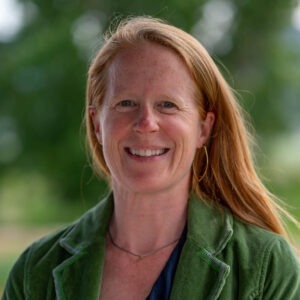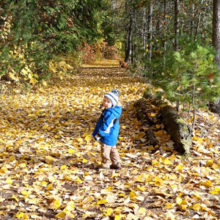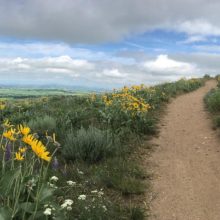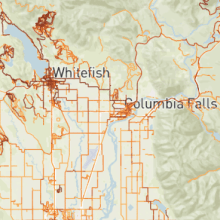- Bonner County’s economy is uniquely diverse for a rural community. Its quality of life—including summer and winter recreation—helps recruit and keep employees in manufacturing, aerospace, and technology and other sectors.
- Further developing the area’s trail system would likely bring between $750,000 and $4.5 million in new spending by visitors to the county, supporting between 12 and 72 jobs.
- Other communities in the region have found that building trail networks that preserve local landscapes and serve local needs with trailheads close to town can have a secondary benefit of attracting visitors and new spending.
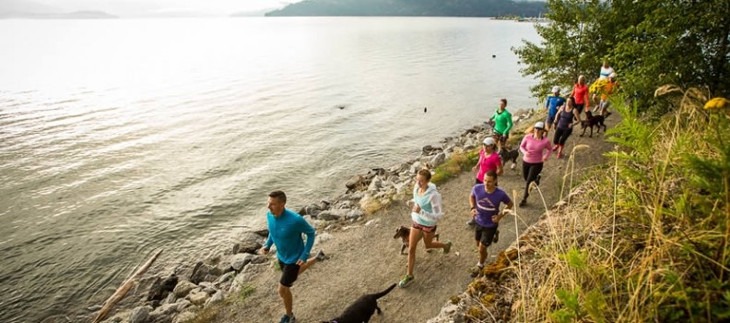
Bonner County is a rural county in northern Idaho, characterized by its vibrant small towns and rural countryside and its mountains, lakes, and rivers. Sandpoint, the county seat, is known in the region and beyond as a tourist and retirement destination, located between Lake Pend d’Oreille and Schweitzer Mountain Resort ski area.
What is less well known are the diverse aspects of the region’s economy built on innovative businesses in advanced manufacturing, aerospace, and software.
This report explores how investments in trails and outdoor recreation could contribute to Bonner County and particularly its ongoing efforts to sustain a diverse rural economy through a strong tourism sector, which in turn fuels the area’s ability to recruit and retain businesses and skilled employees.
Local businesses are competing against other small towns and large areas for small-business owners and skilled employees, and Bonner County’s amenities help provide a competitive edge.
Economic Diversification and Outdoor Recreation in Bonner County
Bonner County is well-suited to further leverage its outdoor recreation economy—fueled by both summer and winter recreation—into a more robust economic engine. The region already has a strong tourism economy that provides the infrastructure, marketing, and reputation needed to fuel trail-based economic tourism.
Research has shown that a well-developed trail system can result in new jobs and income, higher property values, improved public health, and improved quality of life and community identity.
We estimate that further developing Bonner County’s trails would likely result in $750,000 to $4.5 million in new annual spending by visitors to the area. This spending would support between 12 and 72 jobs and $254,000 and $1.6 million in labor income each year.

Our interviews with business leaders highlighted the recruitment value of the area’s high quality of life—including outdoor recreation and a close-knit community. These factors help to attract entrepreneurs and business owners to the area, many of whom first visited Bonner County as tourists.
Building trails does not guarantee economic activity. Bonner County already has tourism-related infrastructure like lodging, restaurants, gear shops, and charter fishing and guide services, but the area would have to further invest in marketing itself and making connections between trailheads and towns (e.g., shuttle services) to encourage spending by visitors. Existing services like the SPOT bus or the Selkirk Recreation District shuttle could provide a foundation for connecting trail users to towns.
The communities of Whitefish, Montana and the Methow Valley in Washington demonstrate that trail networks built with local needs in mind—such as trailheads close to town, funding that relies more on visitors than locals, and preserving working landscapes—result in trail networks championed by local residents that also bring in outside users who generate substantial spending that supports the local economy.
Unlike these communities, Bonner County does not have a single, unified organization that can champion the shared vision of multiple stakeholders.
The Bonner County Trails Plan contains a shared vision of priority trail connections and networks, but without one entity to drive the efforts, it will be difficult to make strategic and well-coordinated progress. In Whitefish and the Methow Valley, the trails organization provided credibility for this strategic vision to the community, landowners, and funding entities.
Several bright spots demonstrate strong momentum to improve access to trails in the community, including Gold Hill, Syringa Trails and Pine Street Woods, and the Sand Creek Watershed. These projects highlight the potential for partnerships between non-profit organizations, state and federal land agencies, and private landowners.
We would like to thank the LOR Foundation for their generous support of this project. We also thank Neal Christensen, Ph.D. of Christensen Research Company (Missoula, Montana) for analysis of the current and potential economic impact of trail-based recreation. Any errors or omissions are solely the
responsibility of Headwaters Economics.
